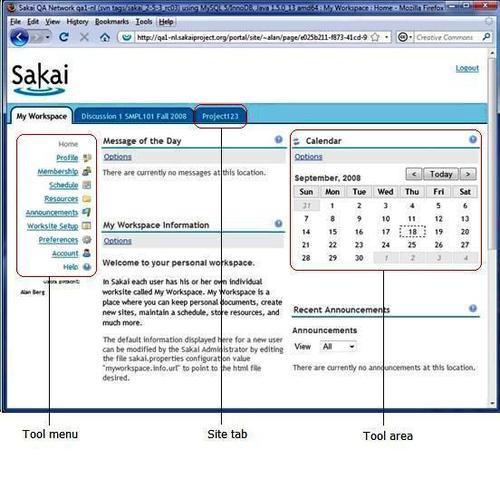The next figure shows a generic Sakai worksite for a newly-created user who has logged on for the first time. On the left side are links to the default set of tools. The main area is for expressing the tools' functionality, and the tabs at the top of the screen enable you to move between sites of which you are a member.

By default, a new user owns a worksite with only a basic set of tools enabled, including a few for self-administration purposes. If the user wants, he or she can request a project, course, or portfolio site:
Project—A project site has two main types of users: the site maintainer and those who can use and share the resources and tools. Typical users of a project site include researchers working on the same study, teachers who wish to compare notes, and ad hoc groups of users who wish to interact together online.
Course—A course site is a virtual online expression of a real course. The target audience are teachers who maintain the site with teaching assistants and students who use the site. Teachers can post exams, send announcements, upload syllabi and grade book results, and choose which tools the students can use to interact. Teaching assistants have less power, but can maintain forums and help maintain processes such as the ebb and flow of marking assignments. Students can chat, take tests, upload files, and send mail to others in the course.
Portfolio—Portfolio sites are places where students store evidence of their work in a structured format. As a student progresses through his or her education or course, that evidence builds up within an online structure set of links and web pages. This can be helpful for finding employment later because potential employers can make judgments based on the evidence presented.
Note
Where have the tools gone?
The demo has more tools to choose from than are normally seen in production; the provisional tools are active to give you an opportunity to play with the technology and judge the tools' value before the next release.
Later chapters cover these three types of sites in more detail, beginning with Chapter 4, My First Project Site. For the administrator, a special admin site includes tools for daily business, such as sending "messages of the day" to the entire user base, managing sites and users, scheduling tasks, and generally tweaking the whole environment. Chapter 10, The Administration Workspace, provides extensive information about this site.



